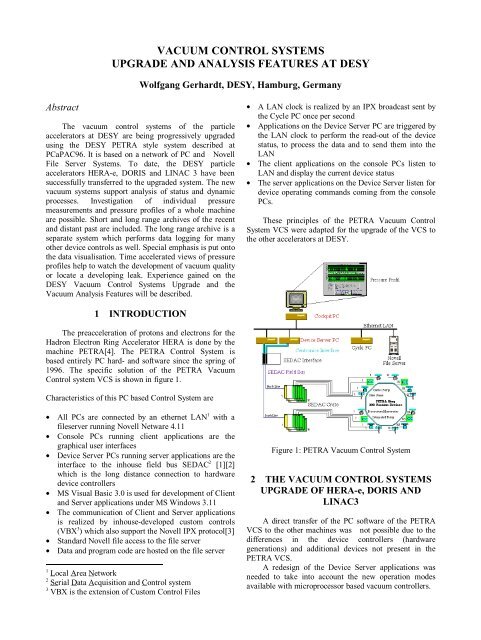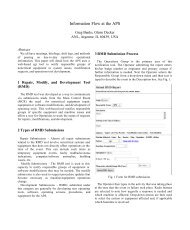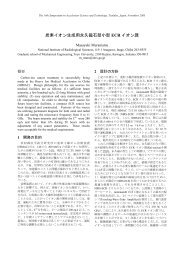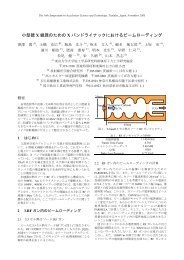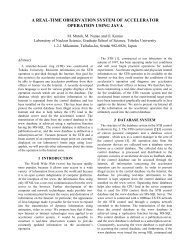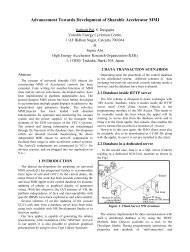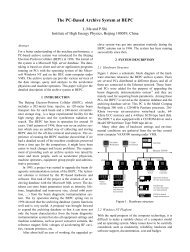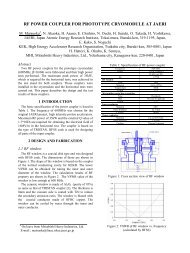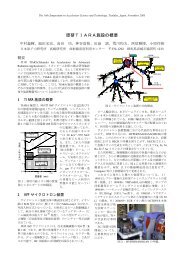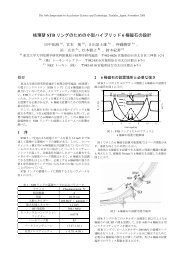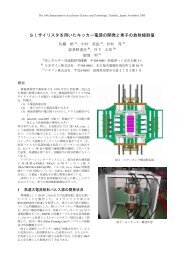vacuum control systems upgrade and analysis features at desy
vacuum control systems upgrade and analysis features at desy
vacuum control systems upgrade and analysis features at desy
You also want an ePaper? Increase the reach of your titles
YUMPU automatically turns print PDFs into web optimized ePapers that Google loves.
Abstract<br />
VACUUM CONTROL SYSTEMS<br />
UPGRADE AND ANALYSIS FEATURES AT DESY<br />
Wolfgang Gerhardt, DESY, Hamburg, Germany<br />
The <strong>vacuum</strong> <strong>control</strong> <strong>systems</strong> of the particle<br />
acceler<strong>at</strong>ors <strong>at</strong> DESY are being progressively <strong>upgrade</strong>d<br />
using the DESY PETRA style system described <strong>at</strong><br />
PCaPAC96. It is based on a network of PC <strong>and</strong> Novell<br />
File Server Systems. To d<strong>at</strong>e, the DESY particle<br />
acceler<strong>at</strong>ors HERA-e, DORIS <strong>and</strong> LINAC 3 have been<br />
successfully transferred to the <strong>upgrade</strong>d system. The new<br />
<strong>vacuum</strong> <strong>systems</strong> support <strong>analysis</strong> of st<strong>at</strong>us <strong>and</strong> dynamic<br />
processes. Investig<strong>at</strong>ion of individual pressure<br />
measurements <strong>and</strong> pressure profiles of a whole machine<br />
are possible. Short <strong>and</strong> long range archives of the recent<br />
<strong>and</strong> distant past are included. The long range archive is a<br />
separ<strong>at</strong>e system which performs d<strong>at</strong>a logging for many<br />
other device <strong>control</strong>s as well. Special emphasis is put onto<br />
the d<strong>at</strong>a visualis<strong>at</strong>ion. Time acceler<strong>at</strong>ed views of pressure<br />
profiles help to w<strong>at</strong>ch the development of <strong>vacuum</strong> quality<br />
or loc<strong>at</strong>e a developing leak. Experience gained on the<br />
DESY Vacuum Control Systems Upgrade <strong>and</strong> the<br />
Vacuum Analysis Fe<strong>at</strong>ures will be described.<br />
1 INTRODUCTION<br />
The preacceler<strong>at</strong>ion of protons <strong>and</strong> electrons for the<br />
Hadron Electron Ring Acceler<strong>at</strong>or HERA is done by the<br />
machine PETRA[4]. The PETRA Control System is<br />
based entirely PC hard- <strong>and</strong> software since the spring of<br />
1996. The specific solution of the PETRA Vacuum<br />
Control system VCS is shown in figure 1.<br />
Characteristics of this PC based Control System are<br />
• All PCs are connected by an ethernet LAN 1 with a<br />
fileserver running Novell Netware 4.11<br />
• Console PCs running client applic<strong>at</strong>ions are the<br />
graphical user interfaces<br />
• Device Server PCs running server applic<strong>at</strong>ions are the<br />
interface to the inhouse field bus SEDAC 2 [1][2]<br />
which is the long distance connection to hardware<br />
device <strong>control</strong>lers<br />
• MS Visual Basic 3.0 is used for development of Client<br />
<strong>and</strong> Server applic<strong>at</strong>ions under MS Windows 3.11<br />
• The communic<strong>at</strong>ion of Client <strong>and</strong> Server applic<strong>at</strong>ions<br />
is realized by inhouse-developed custom <strong>control</strong>s<br />
(VBX 3 ) which also support the Novell IPX protocol[3]<br />
• St<strong>and</strong>ard Novell file access to the file server<br />
• D<strong>at</strong>a <strong>and</strong> program code are hosted on the file server<br />
1 Local Area Network<br />
2 Serial D<strong>at</strong>a Acquisition <strong>and</strong> Control system<br />
3 VBX is the extension of Custom Control Files<br />
• A LAN clock is realized by an IPX broadcast sent by<br />
the Cycle PC once per second<br />
• Applic<strong>at</strong>ions on the Device Server PC are triggered by<br />
the LAN clock to perform the read-out of the device<br />
st<strong>at</strong>us, to process the d<strong>at</strong>a <strong>and</strong> to send them into the<br />
LAN<br />
• The client applic<strong>at</strong>ions on the console PCs listen to<br />
LAN <strong>and</strong> display the current device st<strong>at</strong>us<br />
• The server applic<strong>at</strong>ions on the Device Server listen for<br />
device oper<strong>at</strong>ing comm<strong>and</strong>s coming from the console<br />
PCs.<br />
These principles of the PETRA Vacuum Control<br />
System VCS were adapted for the <strong>upgrade</strong> of the VCS to<br />
the other acceler<strong>at</strong>ors <strong>at</strong> DESY.<br />
Figure 1: PETRA Vacuum Control System<br />
2 THE VACUUM CONTROL SYSTEMS<br />
UPGRADE OF HERA-e, DORIS AND<br />
LINAC3<br />
A direct transfer of the PC software of the PETRA<br />
VCS to the other machines was not possible due to the<br />
differences in the device <strong>control</strong>lers (hardware<br />
gener<strong>at</strong>ions) <strong>and</strong> additional devices not present in the<br />
PETRA VCS.<br />
A redesign of the Device Server applic<strong>at</strong>ions was<br />
needed to take into account the new oper<strong>at</strong>ion modes<br />
available with microprocessor based <strong>vacuum</strong> <strong>control</strong>lers.
The new <strong>and</strong> additional inform<strong>at</strong>ion about the<br />
<strong>vacuum</strong> devices had to be integr<strong>at</strong>ed into the client<br />
applic<strong>at</strong>ions on the console PC.<br />
Additionally there was the desire to maintain as<br />
much as possible the proven graphical interface as it is <strong>at</strong><br />
PETRA for the <strong>vacuum</strong> oper<strong>at</strong>ors.<br />
2.1 DORIS<br />
Applic<strong>at</strong>ions for the separ<strong>at</strong>e oper<strong>at</strong>ion of the<br />
microprocessor based <strong>control</strong>lers were developed. Consol<br />
<strong>and</strong> Device server applic<strong>at</strong>ions for Titanium-Sublim<strong>at</strong>ion<br />
pumps not used <strong>at</strong> PETRA were written.<br />
The DORIS VCS was redesigned in this way in<br />
1997.<br />
2.2 HERA-e<br />
The HERA-e VCS has a much gre<strong>at</strong>er number of<br />
getter pumps as PETRA (about 800, PETRA: 200). So<br />
major changes of the Console <strong>and</strong> Device Server<br />
applic<strong>at</strong>ions were neccessary because of the limited<br />
packetlength of the IPX communic<strong>at</strong>ion interface.<br />
The oper<strong>at</strong>ion programs for the microprocessor<br />
based device <strong>control</strong>ler <strong>and</strong> for the Titanium Sublim<strong>at</strong>ion<br />
Pumps could be transfered from the DORIS VCS.<br />
Applic<strong>at</strong>ions were developed for the following<br />
devices not used <strong>at</strong> PETRA <strong>and</strong> DORIS<br />
• Turbo Pump St<strong>at</strong>ions<br />
• High Voltage oper<strong>at</strong>ion<br />
2.1 LINAC3<br />
At LINAC3, differences in the power supplies of<br />
the getter pumps led to changes in the software of the<br />
Device Server applic<strong>at</strong>ions.<br />
In some <strong>vacuum</strong> sections of the LINAC3 acceler<strong>at</strong>or<br />
there is a lack of pressure inform<strong>at</strong>ion by getter pumps; in<br />
these machine sections Pirani <strong>and</strong> Penning pressure meter<br />
are installed. Major changes in the Console <strong>and</strong> Device<br />
server applic<strong>at</strong>ions were done to show the pressure values<br />
of these different devices in one display.<br />
These modific<strong>at</strong>ions in the software for the VCS of<br />
PETRA does not effect the reliability of the new VCS of<br />
HERA-e, DORIS <strong>and</strong> LINAC3.<br />
In contrary the better performance in terms of a<br />
higher time resolution of st<strong>at</strong>us inform<strong>at</strong>ion (HERA-e: 1<br />
second, 40 seconds before) <strong>and</strong> the <strong>analysis</strong> <strong>fe<strong>at</strong>ures</strong> bring<br />
more clarity into <strong>vacuum</strong> system oper<strong>at</strong>ions.<br />
3 ANALYSIS OF PRESSURE STATUS<br />
3.1 Pressure Display<br />
In the oper<strong>at</strong>ion mode of the acceler<strong>at</strong>ors the getter<br />
pumps supply the main pressure inform<strong>at</strong>ion of the<br />
<strong>vacuum</strong> chamber.<br />
A single pressure value is visualized by a vertical<br />
green bar on the screen <strong>at</strong> the console. The scale runs<br />
from about 1E-12 to 1E-05 mbar.<br />
A pressure profile of all the single pressure values<br />
taken around the acceler<strong>at</strong>or ring is collected within less<br />
than one second. The display is visually prepared in the<br />
comb represent<strong>at</strong>ion[5]. So even for the HERA-e<br />
acceler<strong>at</strong>or there is a clear overview of the nearly 800<br />
pressure values.<br />
The position <strong>and</strong> length of the pressure bars on the<br />
screen correspond to the position <strong>and</strong> pressure values in<br />
the machine.<br />
3.3 Marker<br />
For the visualiz<strong>at</strong>ion of changes of pressure in time<br />
the Marker function is used.<br />
A reference machine profile can be fixed <strong>at</strong> one<br />
instant by setting the Markers: At the top of each pressure<br />
bar a small red horizontal bar is painted. These Marker<br />
signs are permanent until the Marker is set or cleared.<br />
If the pressure values of the profile change in time<br />
the amount of the change with respect to the reference<br />
profile is directly visible in the different positions of the<br />
Marker <strong>and</strong> the endpoints of the pressure bars.<br />
3.4 Range Check<br />
To focus the <strong>at</strong>tention to a pressure value which has<br />
exceeded a previously defined limit there is the Range<br />
Check function: The color of the corresponding pressure<br />
bar is changed to red as long as the limit value is<br />
exceeded.<br />
4 ANALYSIS OF PRESSURE DYNAMICS<br />
4.1 Five Minute Archive: History<br />
Per mouse click a history of every single pressure<br />
measurement in the acceler<strong>at</strong>or of the last five minutes is<br />
provided.<br />
At an upd<strong>at</strong>e r<strong>at</strong>e of once per second a time profile of<br />
the selected pressure measurement can be w<strong>at</strong>ched on the<br />
screen.<br />
The d<strong>at</strong>a for these histories are held in the memory<br />
of the Device Server PCs: About 250KB for HERA-e. At<br />
the request of a console PC the Device Server sends the<br />
d<strong>at</strong>a for the selected pump via IPX telegram over the<br />
LAN: 600 bytes per second.
4.2 One Hour Archive: Playback<br />
The pressure profiles of the whole machine for every<br />
second of the last hour are held in the memory of the<br />
console PC. Thus the d<strong>at</strong>a for 3600 profile pictures are<br />
available for a playback: Showing picture-for- picture <strong>at</strong><br />
ten per second supplies a time acceler<strong>at</strong>ed <strong>vacuum</strong> movie<br />
th<strong>at</strong> starts in the present <strong>and</strong> goes to the past.<br />
• A one hour <strong>vacuum</strong> history of a whole machine<br />
pressure profile shrinks to a six minute playback<br />
show.<br />
• A developing leak propag<strong>at</strong>ing as a pressure wave<br />
through the <strong>vacuum</strong> tube can be studied again <strong>and</strong><br />
again. The option to go step-by-step, picture-forpicture<br />
through the show enables one to loc<strong>at</strong>e a leak.<br />
• The process of the developing <strong>vacuum</strong> quality in the<br />
last hour becomes dram<strong>at</strong>ic in this time- acceler<strong>at</strong>ed<br />
view.<br />
4.3.1 One Month Archive: World Wide Web<br />
There is a separ<strong>at</strong>e long range archive system. It is<br />
independent from the Vacuum Control System <strong>and</strong><br />
performs the d<strong>at</strong>a logging for all the different Device<br />
Control Systems running on PCs.<br />
There are following archived <strong>vacuum</strong> parameters:<br />
• Average pressure of the whole machine<br />
• All the single pressure measurements<br />
• St<strong>at</strong>us inform<strong>at</strong>ion of the g<strong>at</strong>e valves<br />
At present the hard disc capacity for the HERA-e<br />
<strong>vacuum</strong> d<strong>at</strong>a is sufficient for<br />
• 31 days with a time resolution of 20 minutes<br />
• 7 days with a time resolution of 2 minutes<br />
At this time the archived d<strong>at</strong>a are presented in the<br />
World Wide Web in terms of numbers.<br />
4.3.2 One Month Archive: Playback Archive<br />
The Playback Archive is the Playback with an<br />
interface to the Long Range Archive.<br />
So the pressure d<strong>at</strong>a can be presented in the<br />
accustomed comb represent<strong>at</strong>ion.<br />
For any selected time range out of the 31 days the<br />
Playback Archive allows viewing a <strong>vacuum</strong> movie. The<br />
time steps are variable. An eight hour <strong>vacuum</strong> shift could<br />
shrink to an eight minute playback show.<br />
5 CONCLUSION<br />
The PC concept of the PETRA Vacuum Control<br />
System was transferred very successfully to the<br />
acceler<strong>at</strong>ors HERA-e, DORIS <strong>and</strong> LINAC3.<br />
The <strong>systems</strong> are reliable, have a high performance in<br />
terms of the time resolution of presenting the <strong>vacuum</strong><br />
device st<strong>at</strong>us <strong>and</strong> the described <strong>analysis</strong> <strong>fe<strong>at</strong>ures</strong> help to<br />
bring clarity into <strong>vacuum</strong> system oper<strong>at</strong>ions.<br />
6 REFERENCES<br />
[1] H. Frese <strong>and</strong> G. Hochweller, ”The Serial D<strong>at</strong>a<br />
Acquisition System <strong>at</strong> PETRA”, IEEE Nucl. Sci.<br />
26, 1979, pp. 3384.<br />
[2] R. Stadtmüller, ”SedPc - Interfacing SEDAC <strong>and</strong><br />
PCs”, Proceedings PCaPAC’96, DESY, 1997<br />
[3] M. Peters, ”Extensions for Visual Basic”,<br />
Proceedings PCaPAC’96, DESY, 1997<br />
[4] R. Schmitz, ”A Control System for the DESY<br />
Acceler<strong>at</strong>or Chains”, these proceedings<br />
[5] W. Gerhardt, ”Vacuum Control <strong>at</strong> PETRA”,<br />
Proceedings PCaPAC’96, DESY, 1997


